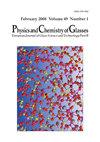Structure of copper tellurite and borotellurite glasses by neutron diffraction, Raman, 11B MAS-NMR and FTIR spectroscopy
IF 0.3
4区 材料科学
Q4 CHEMISTRY, PHYSICAL
Physics and Chemistry of Glasses-European Journal of Glass Science and Technology Part B
Pub Date : 2020-02-14
DOI:10.13036/17533562.61.1.007
引用次数: 5
Abstract
The structure of copper tellurite and borotellurite glasses is studied by x-ray and neutron diffraction, reverse Monte Carlo (RMC) simulations, FTIR, Raman and 11B MAS-NMR spectroscopy. Copper tellurite sample with 15 mol% CuO forms precipitates of tetragonal TeO2 within the glass matrix on melt quenching. The glass forming ability of the xCuO–(100−x)TeO2 system enhances with increase in CuO concentration from 15 to 20 mol% and also with the addition of B2O3. RMC simulations on the neutron diffraction data found that the Cu–O and Te–O bond lengths are approximately at equal distances in the range: 1·96 to 1·98±0·02 Å, while the nearest O–O distance is at 2·71±0·02 Å. Neutron and Raman results on the Te–O speciation are in agreement and confirmed that the Te–O coordination decreases with an increase in CuO and B2O3 molar concentrations in the tellurite and borotellurite glasses, respectively. RMC studies found that Cu2+ has tetrahedral coordination with oxygen, as predicted by Jahn–Teller distortion and that Cu–O and Te–O structural units have very similar size and geometry. The copper tellurite glass-ceramic sample with 15 mol% CuO was heat treated and it formed crystalline precipitates of TeO2 and CuTe2O5 upon devitrification; the average Te–O coordination was significantly smaller in the glass as compared to that in the crystalline sample.用中子衍射、拉曼、11B核磁共振和红外光谱研究了碲铜和硼碲玻璃的结构
采用x射线和中子衍射、反蒙特卡罗(RMC)模拟、红外光谱(FTIR)、拉曼光谱(Raman)和11B核磁共振光谱(MAS-NMR)研究了碲酸铜和硼碲酸铜玻璃的结构。含15mol % CuO的碲酸铜试样在熔融淬火时在玻璃基体内形成四方TeO2析出物。xCuO -(100−x)TeO2体系的玻璃化能力随着CuO浓度从15%增加到20%以及B2O3的加入而增强。对中子衍射数据的RMC模拟发现,Cu-O和Te-O键长在1.96 ~ 1.98±0.02 Å范围内近似相等,而O-O键的最接近距离为2.71±0.02 Å。在碲酸盐玻璃和硼碲酸盐玻璃中,Te-O配位随CuO和B2O3摩尔浓度的增加而减小。RMC研究发现,Cu2+与氧具有四面体配位,正如Jahn-Teller畸变所预测的那样,Cu-O和Te-O结构单元具有非常相似的尺寸和几何形状。对CuO含量为15 mol%的碲酸铜玻璃陶瓷样品进行热处理,脱硝后形成TeO2和CuTe2O5结晶析出;与晶体样品相比,玻璃中的平均Te-O配位明显更小。
本文章由计算机程序翻译,如有差异,请以英文原文为准。
求助全文
约1分钟内获得全文
求助全文
来源期刊

CiteScore
0.70
自引率
33.30%
发文量
0
审稿时长
1 months
期刊介绍:
Physics and Chemistry of Glasses accepts papers of a more purely scientific interest concerned with glasses and their structure or properties. Thus the subject of a paper will normally determine the journal in which it will be published.
 求助内容:
求助内容: 应助结果提醒方式:
应助结果提醒方式:


